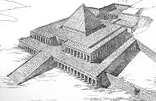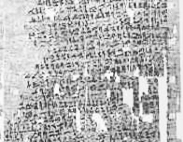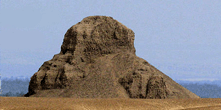2155 B.C. -- birth of Sarah (Sarai).
2090 B.C. -- Abram enters Canaan.
2079 B.C. -- birth of Ishmael.
2066 B.C. -- God destroys four of the five "cities of the plain" (Sodom, Gomorrah, Admah, and Zeboiim) by raining brimstone and fire upon them because of their sinfulness. (Genesis 18:20-19:29)
2065 B.C. -- birth of Isaac.
2028 B.C. -- death of Sarah at the age of 127. (Genesis 23:1)
2025 B.C. -- Isaac marries Rebekah.
2005 B.C. -- birth of Esau and Jacob.
1990 B.C. -- death of Abraham at the age of 175. (Genesis 25:7)
1942 B.C. -- death of Ishmael at the age of 137. (Genesis 25:17)
1914 B.C. -- birth of Joseph.
1885 B.C. -- death of Isaac at the age of 180. (Genesis 35:28)
1804 B.C. -- death of Joseph at the age of 110. (Genesis 50:26)
1525 B.C. -- birth of Moses.
1485 B.C. -- Moses kills an Egyptian and flees to the land of Midian.
1484 B.C. -- birth of Caleb, the son of Jephunneh, the Kenizite.
1445 B.C. -- the Israelite Exodus from Egypt, and the year that Moses receives the commandments for the Old Covenant from God on Mount Sinai.
1444 B.C. -- the Israelites reach the promised land, the land of Canaan, but refuse to go in, so God sentences them to wander 40 years in the wilderness until all the adults--except for Joshua and Caleb and their families--die. (They received a one-year credit for "time served" because they had already been in the wilderness for one year on their way to the promised land.)
1405 B.C. -- death of Moses at the age of 120 (Deuteronomy 34:7), and the year that the children of Israel cross the Jordan River and enter the land of Canaan.
605 B.C. -- Nebuchadnezzar II (Nebuchadrezzar II) of Babylonia invades Judah and takes a number of Jews captive to Babylon, Babylonia, including Daniel, Hananiah, Mishael, and Azariah (This is known as the first deportation.), thus signifying the beginning of the Babylonian Captivity.
601 B.C. -- Babylonia attacks Egypt.
597 B.C. -- the second deportation of Jews from Judah to Babylon, Babylonia.
587 B.C. -- the destruction of Jerusalem and the temple, and the third deportation of Jews from Judah to Babylon, Babylonia.
582 B.C. -- the fourth deportation of Jews from Judah to Babylon, Babylonia.
568 B.C. -- Babylonia attacks Egypt.
562 B.C. -- King Nebuchadnezzar II dies and Evil-Merodach (Amel-Marduk), the son of Nebuchadnezzar II, begins to reign.
560 B.C. -- King Evil-Merodach dies and Nergal-Sharezer (Nergal-Sarezer, Nergal-shar-usur, Nariglissar), the husband of Nebuchadnezzar II's daughter, ?, begins to reign.
556 B.C. -- King Nergal-Sharezer dies and Labashi-Marduk, the son of Nergal-Sharezer, begins to reign and reigns for 9 months.
556 B.C. -- King Labashi-Marduk dies and Nabonidus (Nabunaid), the husband of Nebuchadnezzar II's daughter, Nitocris, begins to reign.
553 B.C. -- Belshazzar (Bel-shar-usus), the oldest son of King Nabonidus, begins to reign with his father.
539 B.C. -- King Cyrus II (the Great, the Persian), the king of the Persian empire, the son of Cambyses I, conquers Babylon (by his general, Ugbaru, because he, himself, did not arrive until about 2½ weeks later), killing King Belshazzar in the process, and appoints 62-year-old Darius the Mede (Median), the son of Ahasuerus, as the king of Babylon under him. (King Darius the Mede is not to be confused with Ugbaru (Gubaru or Gobryas), the former Guti governor of Gutium, who was Cyrus the Great's general and who died about 3½ weeks after conquering Babylon.)
535 B.C. -- the first group of Jews return to Judah from Babylon, thus signifying the end of the Babylonian Captivity.
6 B.C. -- Jesus is born in Bethlehem, Judea, Israel on or about the first day of autumn. (Tishri 1st on the Jewish calendar.)
8 -- Jesus, at the age of 12½, stays behind at Jerusalem after the Feast of Passover, without telling His parents.
29 -- Jesus, at the age of 33½, is crucified, dies, is buried, and raised from the dead.
66 -- the Jews rise up in rebellion to Rome.
70 -- the Romans finally quell the rebellion (win the war) and destroy and burn Jerusalem and the temple and take tens of thousands of Jews (including some Christian Jews) to Rome as slaves.
79 -- Mount Vesuvius, on the western coast of the nation of Italy, erupts and the cities of Herculaneum and Pompeii are destroyed. This was God’s judgment on these cities because of their wickedness. Archeologists have found abundant evidence in the ruins of Herculaneum and Pompeii of the sin and iniquity that they were involved in. This was very similar to what happened to the cities of Sodom and Gomorrah in 2066 B.C. (Genesis 18:20-19:29), when they were destroyed because of their sinfulness.
313 -- the Roman emperor Constantine founds the Roman Catholic Church and becomes its first pope. Pope Constantine presides over the Roman Catholic Church until his death in 337, and is succeeded by the second pope, Pope Julius I, who is pope from 337 to 352.
321 -- the Edict of Constantine.
325 -- the first Council of Nicea.
354 -- the Roman Catholic Church and Pope Liberius (the third pope of the Roman Catholic Church) choose the date of December 25th for the celebration of Jesus' birth.
476 -- the Western Roman Empire falls, thus signifying the beginning of the Dark Ages.
1200 -- the approximate year that the Bible is divided into chapters.
1254 -- the Roman Catholic Church and Pope Innocent IV (the 167th pope of the Roman Catholic Church) officially formulate the (false) doctrine of purgatory.
1450 -- Johannes Gutenberg invents the printing press (with movable type) in Mainz, Germany.
1453 -- Constantinople and the Eastern Roman Empire (the Byzantium Empire) fall, thus signifying the end of the Dark Ages.
1456 -- the Gutenberg Bible (a.k.a. the Mazarin Bible or the 42-Line Bible), the first book produced on a printing press (with movable type), is printed in Latin.
1517 -- Martin Luther affixes his 95 theses to the castle church door of the University of Wittenberg, in Wittenberg, Saxony, Germany, on October 31st, thus signifying the beginning of the Reformation.
1551 -- the New Testament is divided into verses.
1560 -- the Old Testament is divided into verses.
1603 -- Queen Elizabeth I dies and King James I succeeds to the throne of England.
1604 -- the Christians (many of which were Puritans) request of King James I that a new English translation of the Bible be made.
1604 -- translation begins on the Authorized Version (the King James Version) of the Bible under the order of King James I.
1611 -- the Authorized Version (the King James Version) of the Bible is finished being translated from the Masoretic Text (the Old Testament) and Textus Receptus (the New Testament) and is published.
1965 -- After reading a chapter of a manuscript of her husband’s book entitled “World Aflame” that described the sinful conditions of America, Ruth Graham says to Billy, “If God doesn’t judge America, He’s going to have to apologize to Sodom and Gomorrah.”
1988 -- Batavia Christian Center / Matthew Norville Ministries is founded in Batavia, Illinois, U.S.A., and holds its first service on Sunday, June 5th.home page











